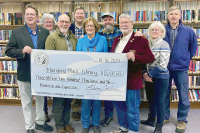Forest plan timeline lengthens
 The timeline for a draft forest management plan has been kicked back once more, with the document now expected sometime at the very end of 2016.
The timeline for a draft forest management plan has been kicked back once more, with the document now expected sometime at the very end of 2016.
“What we’re discovering now is we have a lot more pieces of the forest plan to share, and we want to put all these pieces out to the public in advance of coming out with a formal draft,” said Michelle Aldridge, forest planner.
The new 20-year plan for the Pisgah and Nantahala national forests is taking place under a brand new planning process, which Aldridge says is meant to emphasize transparency and to include opportunities for public input along the way. Currently, the U.S. Forest Service is posting bits and pieces of what will eventually become the draft plan online to allow for public feedback before the formal document is released.
“The goal is that when we actually get to that draft, that people are not surprised,” she said.
When the planning process began in 2014, the idea was to have a draft plan released by June 2015 and to approve the final plan in August 2016. But sharp disagreement in early discussions about habitat management and wilderness designation led the Forest Service to hit pause on the timeline, allowing for stakeholders groups to work through some of those differences before any decisions were made on some of the more controversial parts of the plan.
The new goal became to release a draft plan in fall 2016, but now the planning team is realizing that won’t happen either. The parts of the plan most likely to draw sharp opinion — recommendations for areas to designate as wilderness, for example, and specific shorter-term management goals — are yet to be released. They decided to move the timeline back so that there would be some chance for public feedback between their release and progress on the formal draft.
Related Items
“The thinking is that if we spend a little bit more time on plan development, it will be smoother and quicker to go between draft and final, and hopefully we’ll have developed a more broadly supportive plan,” Aldridge said.
Toward that goal of getting forest users on board with the process, the Forest Service has opened its planning meetings to public observation. The planning meetings aren’t public comment periods or even formal meetings — they’re essentially work sessions, when the planning team gets together to hash through the particulars of the plan, pulling together their various specialties and public input to make decisions. They decided to open the meetings after hearing people say they wanted a better understanding of how, exactly, the planning decisions were made.
“As more folks have seen that we’ve got lots of considerations for any one facet of the plan, it’s helped them to understand the thinking,” Aldridge said. “I’m hoping that it helps people to see how we’re considering their input.”
While the Forest Service has released many pieces of the plan so far, it has yet to post the one-the-ground goals it will be looking to meet over the next 20 years — those sections, called “objectives” could generate a good deal of discussion when they are released, likely in the early part of the summer.
Shortly after the objectives come out, the next step of the wilderness recommendation process will likely be released. Wilderness is a designation that requires Congressional action, placing additional restrictions on land covered so as to preserve its primitive, wilderness characteristics. The wilderness question has sparked perhaps some of the sharpest disagreement of the forest planning process, with wilderness advocates saying that wilderness designation is the best way to protect the forest’s most environmentally valuable areas. Meanwhile, wilderness opponents say that designation keeps the Forest Service from working with a full set of management tools and would impair species like deer and grouse, which require young forest habitat to thrive.
Last year, the Forest Service completed its wilderness inventory, a list of 52 areas that could possibly contain some wilderness characteristics and merit evaluation. This summer, evaluations of those 52 areas will be released.
“That’s not to say those 52 areas will be recommended — definitely not that at all,” Aldridge said. “It’s just that our initial process said we needed to look closer at these 52 areas and talk about whether they contain (wilderness) characteristics.”
After the evaluations are released, the next step, to be released with the draft plan, will be to analyze what the effects would be if the areas were designated as wilderness. The final recommendations for areas to receive Congressional designation will be released at the end of 2017.
Stay in the loop
The U.S. Forest Service planning sessions to create a new forest management plan for the Pisgah and Nantahala national forests are now open to the public.
They’re not public meetings designed to take comment or allow public participation — the idea is to give interested people a chance to see how the planning process works and how the Forest Service considers input from the public and its specialists when making a decision.
To attend, email Heather Luczak at This email address is being protected from spambots. You need JavaScript enabled to view it. to be notified when a meeting is planned. RSVPs to individual meetings are requested.
All forest plan materials are online at http://1.usa.gov/1TI6AEz.









